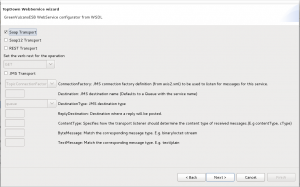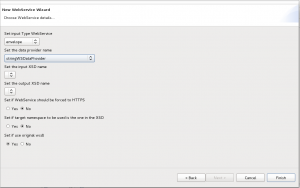Difference between revisions of "Web Services"
(→Create new {{GVWS}} with {{VULCON}}) |
(→Create new {{GVWS}} with {{VULCON}}) |
||
| Line 19: | Line 19: | ||
==Create new {{GVWS}} with {{VULCON}}== | ==Create new {{GVWS}} with {{VULCON}}== | ||
[[File:ws1.png|thumb|WebService Wizard first window]] | [[File:ws1.png|thumb|WebService Wizard first window]] | ||
| − | VulCon provides two wizards to create new Web Services. The first one starting from an {{GVESB}} service and creating the WSDL and the AAR to deploy ([bottom-up development method]), the second one, starting from a WSDL, creating {{GVESB}} services for each operation chosen ([top-down development method]). | + | VulCon provides two wizards to create new Web Services. The first one starting from an {{GVESB}} service and creating the WSDL and the AAR to deploy ([[bottom-up development method]]), the second one, starting from a WSDL, creating {{GVESB}} services for each operation chosen ([[top-down development method]]). |
'''bottom-up development method''' | '''bottom-up development method''' | ||
Right click on GVServices-->Services label and select "Wizard New WebService...". | Right click on GVServices-->Services label and select "Wizard New WebService...". | ||
Revision as of 10:23, 1 February 2012
Definition
Web Service is a software system that allows the interoperability among machines on the same network. Through a Web Service it is possible to pubblish business services using a contract, called WSDL.
GreenVulcano® ESB provides a very simple method that helps developers to manage Web Services operations as:
- create
- invoke
- deploy
- publishing
- undeploy
Any service flow can be pubblished in GreenVulcano® ESB as a Web Services.VulCon® helps the user to pubblish an ESB service as a web service, leaving the user the only task to define the data structures in order to interact with the external world.
GreenVulcano® ESB provides a complete management of Web Services through Axis2 platform. It supports:
- Web Services stateful and asynchronous
- Processing SOAP Messages with XML parsing more efficient pull-based instead of DOM (Document Object Model)
- Increased Scalability
- Hot deploy and undeploy
Create new Web Services with VulCon
VulCon provides two wizards to create new Web Services. The first one starting from an GreenVulcano® ESB service and creating the WSDL and the AAR to deploy (bottom-up development method), the second one, starting from a WSDL, creating GreenVulcano® ESB services for each operation chosen (top-down development method). bottom-up development method Right click on GVServices-->Services label and select "Wizard New WebService...". New WebService Wizard window will be open. Fill the window fields as following:
- In the "WebService name" field set the WebService name that you want to publish
- In the "target namespace" field if you want you can change the default operation target namespace proposed
- In the "Operation" field choose the operation to bind from list proposed.
On the second page you can change:
- Soap Action and the mapped operation name to the WebService-This optional property is set on an outgoing SOAP/JMS request message to indicate the soapAction value associated with the Web services request. This property is similar to the SOAPAction HTTP header used when transporting Web service requests over an HTTP transport. The value of the soapAction property is a URI identifying the intent of the SOAP request. If the soapAction property is specified, it is used by the server component to determine the target of the request. The SOAP specification places no restrictions on the format or specificity of the URI or that it is resolvable. Typically, this property is set to the soapAction value from the WSDL document.
On the third page you can choose your preferred transport protocol. The properties indicates the version number of the protocol used by the client and server.If the SOAP request message represents a two-way request, the client component must set the JMS message.
- Soap Transport
- Soap12 Transport
- Rest Transport
- JMS Transport
If you choose Rest Transport, you must additionally select the verb for the operation. If you choose JMS Transport, you must additionally:
- select The jms connection factory
- JMS destination name
- JMS destination type
- Reply destination: Destination where a reply will be posted
- contentType:This property is similar to the Content-Type header found in an HTTP message and is used to describe the content type of the message
- ByteMessage
- TextMessage
On the fourth and last page you must choose:
- The WebService input type
- The DATA PROVIDER name
And optionally
- The input XSD name
- The output XSD name
And check the preferred Radio Button for:
- HTTP or HTTPS
- Target namespace that WebService use, is or not is in the XSD
- Use or not use the original wsdl
{{#w4grb_rate:}} <w4grb_ratinglist latestvotes items="5" nosort/>



